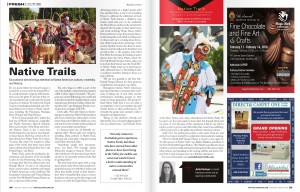Native Trails spotlights Native American culture
Educational series brings attention to Native American culture, creativity, and history.
By Julie Carlson
Do you know where the Grand Canyon is located? In a recent survey by Intrepid Travel, a small adventure company with destinations across the globe, 57 percent of the survey respondents had no idea that the Grand Canyon is in Arizona. Not only is the Grand Canyon a breathtaking landmark and a National Park, but it’s home to Native Americans, including the Havasupai, Hualapai, Dine’ (Navajo) and Hopi Nations.
“A lot of young people don’t realize this land was all Native Americans’, originally,” says Native Arizonian Derrick Suwaima Davis and member of the Hopi and Choctaw Nations. Davis is also a seven-time world champion hoop dancer and champion fancy dancer. Davis has served as the artistic director for Native Trails for 14 years. “It seems like when I’ve traveled to other parts of the world, they know more about native cultures than [those] who live in the United States,” says Davis.
Native Trails, under the production, development, and direction of the Scottsdale Center for the Performing Arts, is trying to change that. This free cultural series runs through March 31 and is an educational way to see the talent, creativity, and history of Native Americans in the southwest. The Scottsdale Convention and Visitors Bureau and the Fort McDowell Yavapai Nation are also co-sponsors of the events.
The series began in 2003 as part of the city of Scottsdale’s cultural tourism initiative called Culture Quest Scottsdale. “The program was created following a city-conducted study that revealed Scottsdale tourists craved experiencing American Indian culture during their visit,” says Stephanie Pressler, communications manager of SCVB.
Davis adds, “Not only visitors to Scottsdale get to experience Native Trails, but those who have moved from other places or have been living in the Valley for awhile can come and watch to have a better understanding of native communities around them.”
In Arizona there are 22 federally recognized tribes. About eight cast members, including Davis, perform in Native Trails. Dancing and music plays a big part among each Native American tribe.
“Sometimes people have misconceptions,” says Davis. “For example, natives fitting into savages or warriors. There’s another whole part of it that doesn’t get told in schools or in previously written books. But it’s getting better.”
The hour-long show opens with a camp dance about a time when native peoples migrated to become one with their centers and when they finally arrived at their destination. Next is beautiful flute music to honor the plants and insects as the first singers and dancers on earth; the Eagle Dance is about delivering prayers to a higher power; after this spiritual dance is the Corn Grinding Dance to celebrate the cultivation of food, or Native Trails features a children’s song (native youth take part on the weekend); the Horse Dance embraces the arrival of the Spanish who brought to these lands horses and metal smithing; Hoop Dance (which Davis performs) recaps the previous dances by discussing the circle of life and the power of choice; next up is a rousing drum formation which breaks down stereotypes of the warrior rhythm because the drum in native dances is used to indicate the heartbeat; and second-to-last is the popular inter-tribal Pow Wow that invokes the feeling of native dances from the Great Plains, which the Fort McDowell Yavapai Nation takes part in to share their history near the Verde River. Native Trails wraps up its performance with a Round Dance or Friendship Circle, so audience members itching to dance can join in the fun.
“We are very grateful to the Fort McDowell Yavapai Nation for their generous contributions and support,” says Davis.
Throughout history, Native Americans have done their best to maintain their traditions of taking care of each other and the environment, including passing on their stories to future generations. The group behind Native Trails feels it sets out what it accomplishes to do. Cast members also add cheeky humor to their performances. Afterwards the group stays around to talk to attendees and take pictures.
“Being on this platform, literally and figuratively, I am constantly digging deeper into my cultural roots,” says Yolanda Tsosie of the Dine’ Nation and a fancy shawl dancer for Native Trails. “It has given me that extra push to share what I’ve learned, lived, and my point of view. Because of this experience, I feel it’s my role to inspire people to get in touch with where they come from, and bring a fresh perspective to the public about Native American culture.”
Aside from the performances there is also native food, arts and crafts, from baskets to jewelry to sculptures to bow and arrow making.
“The Fort McDowell Yavapai Nation is proud to once again be the title sponsor of Native Trails,” says Ruben Balderas, president of the Fort McDowell Yavapai Nation. “The Tribal Council knows local residents and visitors alike will enjoy learning about the various native tribal cultures and partaking in the exciting exhibits and shows. Native Trails is truly a unique, once-in-a-lifetime experience.”
For more information, visit scottsdalenativetrails.com.
Native Trails
Performances every Thursday and Saturday from 12 p.m. to 1 p.m. through March 31.
Scottsdale Center for Performing Arts 7380 E. Second St, Scottsdale
Related posts
Leave a Comment
You must be logged in to post a comment.







